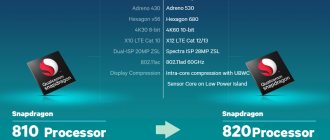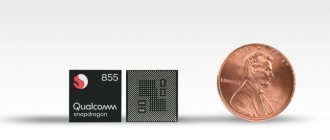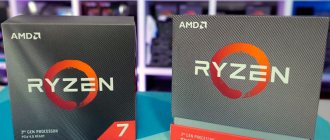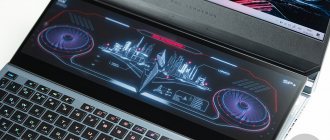With the advent of the Snapdragon 700 series chipsets, Qualcomm has shaken the boundaries between mid-budget and flagship smartphones.
The first processor from the new line was the 8-core Snapdragon 710, which is similar in characteristics to the popular chip with the 660 index, but has a number of significant changes. First of all, they relate to increasing energy efficiency due to the transition to a 10-nm process technology, like the top Snapdragon 845. There are 8 cores here, they are arranged in 2 clusters: 2 productive Cortex A75 cores with a frequency of up to 2.2 GHz and 6 Cortex A55 with frequency 1.7 GHz, Kryo 360 architecture.
For the first time, an affordable chipset received support for the Adreno 616 video accelerator, providing a huge performance boost. The ISP Spectra 250 is responsible for image processing, and it is complemented by a Hexagon 685 signal processor, which facilitates interaction with artificial intelligence algorithms. At the same time, the processor supports one camera with a resolution of 32 megapixels or two cameras of 16 megapixels. For communication needs, an LTE Snapdragon X15 modem is installed, supporting Wi-Fi 802.11ac, Bluetooth 5.0, Aqstic and aptX technologies. If provided by the smartphone manufacturer, the chipset allows the use of Quick Charge 4.0+ fast charging.
Samsung
At the end of 2020, the South Korean company introduced the first smartphone with a dot cutout for the front camera. The device was called Samsung Galaxy A8s and until the end of January 2020 was sold only in China. Then the Galaxy A9 Pro (2019) entered the international market. The phones have thin frames, a 24 megapixel selfie module and a main camera with three sensors with a resolution of 24, 5 and 10 megapixels.
The devices are protected from water and dust according to the IP68 standard, have a memory ratio of 6/128 GB and support microSD cards up to 512 GB. The image is conveyed by a 6.4-inch AMOLED display, the battery capacity is 3400 mAh, and it is charged via the USB Type-C connector.
Xiaomi
The brand's first smartphone powered by Snapdragon 710 was the Xiaomi Mi8 SE. It remained exclusive to the Chinese market, but this did not stop it from gaining popularity due to custom firmware. The phone is interesting with a juicy AMOLED screen with a resolution of 2244 x 1080 pixels, a diagonal of 5.88 inches and a notch in the shape of a bang. On the back there are two camera modules of 12 and 5 megapixels, the front panel is equipped with a 20 megapixel sensor. The device is available in 4/64, 6/64 and 6/128 GB versions, and the battery capacity is 3120 mAh.
Xiaomi CC9 was presented at the beginning of July 2020. The smartphone is aimed at a youth audience with a focus on advanced photo capabilities. The front panel is occupied by a 6.14-inch AMOLED screen with a resolution of 2340 x 1080. The fingerprint scanner is located under the display, which is protected by Corning Gorilla Glass 5. The front-facing camera module of 32 MP with an f/2.0 aperture is placed in a drop-shaped cutout. The main camera is a Sony IMX586 sensor with a resolution of 48 megapixels, an 8 megapixel wide-angle lens (118°) and a 2 megapixel depth sensing module.
Performance is supported by 6 GB of LPDDR4X RAM and 64/128 GB of internal UFS 2.1 storage. The battery life is provided by a 4030 mAh battery with support for 18 W fast charging. The output for 3.5 mm headphones was left, providing the Xiaomi CC9 with Hi-Res Audio support. There is Bluetooth 5.0, Wi-Fi 802.11 (2.4/5 GHz), an infrared port for controlling equipment and NFC. The OS is Android 9.0 Pie. Nothing is known about the release of the smartphone on the world market.
No. 4 – Xiaomi Mi8 SE
Price: 16,300 rubles
Xiaomi Mi8 SE is another attractive product from the Chinese company in terms of price-quality ratio. The popular model received a 5.88-inch display made using AMOLED technology with a resolution of 2244 by 1080 pixels. Such characteristics will allow the user to enjoy a picture with a high level of saturation and contrast, as well as maximum viewing angles, in any conditions.
One of the advantages of the model is its compactness. It weighs only 164 grams and has dimensions of 73.09×147.28×7.5 mm, which makes it as ergonomic and easy to use as possible. The Snapdragon 710 processor, complemented by 4 or 6 GB of RAM, copes with its task perfectly and gives the user the opportunity to play any project at maximum graphic settings and without throttling. The list of weaknesses of the gadget is very small. First of all, this is the absence of NFC and a 3.5 mm connector. Secondly, the unibrow is too massive.
Xiaomi Mi8 SE
OPPO
The Chinese brand presented the OPPO RX17 Pro, which is capable of surprising with a rich AMOLED display, with a built-in fingerprint scanner and a drop-shaped cutout for a 25 MP front camera. On the back panel there is a triple camera unit with support for optical stabilization. The 3700 mAh battery is compatible with SuperVOOC fast charging via the USB Type-C connector. The user will have 6 GB of RAM and 128 GB of ROM.
OPPO K3 continues to develop the idea of frameless smartphones. The 6.5-inch OLED display with a resolution of 2340 x 1080 and an in-display fingerprint scanner features a thin bezel at the top and a middle chin. A 16 MP (f/2.0) selfie lens pops out of the body.
On the glass cover at the back there is a 16 MP camera and a 2 MP depth sensor. RAM 6 or 8 GB, permanent memory 64/128/256 GB UFC 2.1 format. The 3,765 mAh battery supports 20W fast charging. Android 9.0 Pie operating system with proprietary ColorOS 6.0 interface. There is no NFC chip, but there is a 3.5 connector.
Oppo Reno is the basic version of the line of the same name. On the front panel there is a 6.4-inch AMOLED display with a resolution of 2340 x 1080. The screen occupies 87% of the front area. The 16 MP selfie camera is mounted on a pop-up mechanism in the shape of a switch button. A dual camera with 48 megapixel Sony IMX586 was placed at the back.
The smartphone comes in variations with 6/8 GB of RAM and 128/256 GB of permanent memory in UFS 2.1 format. The 3765 mAh battery supports VOOC 3.0 fast charging. NFC, 3.5-connector and USB Type-C 2.0 are included.
4OPPO RX17 PRO
Processor: 8-core Snapdragon 710, clock frequency 2.2 GHz;
Screen: 6.4 inches, resolution 2340 x 1080; Cameras (main / front): 12 + 20 megapixels / 25 megapixels; Memory (RAM / built-in): 6 GB / 128 GB; Battery capacity: 3700 mAh. Price: from 45,000 rub. A Chinese smartphone belonging to the first league and having a thin design with a metal frame, as well as a large Amoled display with a built-in fingerprint scanner. Oppo pays particular attention to the appearance of its devices, and this model is no exception. It has all the modern features, including NFC, and a good battery with VOOC fast charging.
They offer powerful Sony cameras with AI functions that are excellent at shooting at night and support spatial depth measurement technology, which is useful when using AR applications and for better object recognition. The price is quite high for a pre-flagship smartphone, but this is due to the special capabilities of the main camera with an additional TOF 3D sensor.
Nokia
HMD has also released a smartphone on the current platform. The device is called Nokia 8.1 and is almost a complete analogue of the Nokia X7 presented in China. The device was born in the summer of 2020, hence the presence of a bulky notch on a 6.18-inch IPS screen with support for PureDisplay technology and a resolution of 2246 x 1080 pixels. One interesting thing is that there is an optical stabilization system for the main 12 MP camera, where the second lens with a 13 MP sensor is used to determine the depth of the scene.
Adherents of classic headphones will appreciate the presence of a 3.5 mm jack, which was implemented despite the USB Type-C port. The device's battery has a capacity of 3500 mAh. The device is included in the Android One program, which guarantees that you will receive the latest versions of the OS in the coming years.
Meizu
Following last year's flagships with Snapdragon 845, the company introduced a simplified Meizu 16X. Like older models, the smartphone seems to reject trends and offers a widescreen AMOLED display with a built-in fingerprint scanner without notches or waterdrop notches. Instead, there are classic small frames. On the front panel there is a 20 MP camera, while on the back there are two 12 MP photo modules with optical stabilization. The battery offers a capacity of 3100 mAh.
The counterweight to the previous model is Meizu X8. It represents the class of budget devices, offers IPS matrices and a cutout in the form of a bang. The 20 megapixel front camera is designed for selfie lovers, and the block of two main cameras received a 12 and 5 megapixel module. The fingerprint scanner has been moved to the rear panel, the USB Type-C port and the 3.5 mm jack have retained parity, appearing together in one device. The battery capacity was 3210 mAh. Unlike other devices on the list, Meizu devices do not have NFC. By the way, smartphones with a chip for contactless payment, released only for the Chinese market, are incompatible with the Google Pay service in other countries (not to be confused with international versions of smartphones).
Snapdragon 710 and 835
Of course, the most interesting comparison is the search for differences between the Snapdragon 710 and Snapdragon 835. How is the new product inferior or superior to the most powerful Qualcomm processor of last year? The difference between the two solutions is quite significant and concerns not only performance:
- CPU (cores and frequencies): Snapdragon 835 has 4 powerful cores (2.45 GHz) and 4 energy-efficient ones (1.9 GHz). The Snapdragon 710 has only two powerful (2.2 GHz) and six energy-efficient (1.7 GHz);
- CPU (microarchitecture): SD 835 cores use Kryo 280 microarchitecture. SD 710 uses Kryo 360. The second is more modern, but there is more high-speed cache in Kryo 280;
The main “catch” of the Snapdragon 710 is only two powerful cores at a frequency of 2.2 GHz. However, the latest Kryo 360 microarchitecture partially compensates for this shortcoming
- GPU: The Adreno 540 GPU is responsible for the graphics in the SD 835. It has 256 units operating at a frequency of 710 MHz. Adreno 616 from Snapdragon 710 should have half (!) fewer blocks, in addition, it is already known that they operate at a frequency of 500 MHz;
- RAM: Snapdragon 835 supports RAM with a bandwidth of 29.8 GB/s. For Snapdragon 710 the limit is 14.9 GB/s;
- Modem: The Snapdragon 835 has a built-in X16 modem, which provides peak data download speeds on LTE networks of 1 Gb/s (LTE Cat 16). The SD 710 uses an X15 modem. Its limit is 800 Mb/s (Cat 15);
Snapdragon 710 is the first processor in the new “pre-flagship” 7xx line, which Qualcomm simply did not exist before
- Fast charging: Snapdragon 710 stands out with support for Quick Charge 4+ fast charging technology. It is 15% faster than Quick Charge 4, which is found in the Snapdragon 835;
- Wireless charging: Snapdragon 835 supports Qualcomm's proprietary WiPower wireless charging technology. Judging by the official website, there is no similar support for this technology in the SD 710.
Thus, the miracle, alas, did not happen. Even though it was last year, the flagship Qualcomm Snapdragon 835 processor is by some margin superior to the new product in question in all key performance parameters, in addition to outperforming its competitor in technology, with the exception of fast charging, which will be a little faster in the SD 710.
In turn, the Snapdragon 710 has a more affordable price tag. Accordingly, smartphones where this SoC will become the main one will be offered clearly cheaper than flagships, even last year’s ones.
As for specific tests, at the time of writing, not a single smartphone with Snapdragon 710 has gone on sale. However, a certain device with a Snapdragon 710 has already appeared in the popular benchmark (test) GeekBench and showed the result:
Preliminary results of Snapdragon 710 in the GeekBench 4 test
- 1875 points in single-core mode;
- 5886 points in multi-core mode.
By comparison, in the same test, the Galaxy S8 smartphone, the American version of which is equipped with a Snapdragon 835, according to the authoritative Western resource PhoneArena, shows the following results:
- 2008 points in single-core mode;
- 6575 points in multi-core mode.
Much here, of course, depends on the specific device and its optimization, but these figures can still give a general picture of the differences in performance between the 710 and 835. By the way, meet Meizu 16 – one of the most popular smartphones based on Snapdragon 710:
If you look not at the differences, but at the general features, then the main thing is: Snapdragon 835 (MSM8998) and Snapdragon 710 are created on the basis of a 10 nm process technology. This is one of the most relevant technological processes today, although the production of some particularly powerful mobile processors at standards below 10 nm has already begun.
Qualcomm Snapdragon 710 announcement video
See also: comparison of Snapdragon 636 with 710 and other processors. See also: new characteristics of smartphones 2020: we help with the choice.
Lenovo
The first smartphone from the Chinese brand to use the Snapdragon 710 processor was the Lenovo Z5 Pro. It is notable for its slider form factor, 6.39-inch display with AMOLED matrix and on-screen fingerprint scanner. The screen occupies 95% of the front panel. There are four cameras here: two front ones of 8 and 16 megapixels and two main ones of 24 and 16 megapixels. There is no headphone jack; it has been replaced with a USB Type-C adapter. There are two versions to choose from, with 6 GB of RAM and 64/128 GB of internal storage. The battery capacity is 3350 mAh, there is NFC.
The second device was Lenovo Z5s. This is a budget model with a modern design, where the 6.3-inch display with a resolution of 2340 x 1080 has a miniature U-shaped cutout for a 16 MP front camera. The device screen occupies 92.6% of the front area. The ends of the device are made of aluminum, and the back cover is protected by Corning Gorilla Glass. The camera here is triple (16, 8 and 5 megapixels), there is a regular fingerprint sensor. The 3300 mAh battery is charged via the USB Type-C port. On sale there are modifications of 4/6 GB of RAM and 64/128 GB of internal memory.
Lenovo Z6 Youth Edition is the brand's third SD710 smartphone. Its 6.3-inch IPS screen supports HDR10 technology and occupies 93% of the front panel. A drop-shaped cutout was placed on top of the display for a 16 megapixel camera. The glass back panel houses a block of three cameras. There is a headphone jack, and the 4050 mAh battery is charged via USB Type-C. More about the smartphone in our article.
What's good about the Snapdragon 710 processor?
Energy efficiency is a key feature of this chip, it demonstrated the best result among previous Qualcomm processors, also ahead of last year's Snapdragon 835. All thanks to the new Kryo 360 architecture, built on a 10nm process technology, which uses two powerful Cortex A75 cores (2.2 GHz) and six energy-efficient Cortex A55 (1.7 GHz). This architecture is used in the Snapdragon 845. Graphics and intelligence - other features of the chip are the Andreno 616 GPU and the new generation Spectra 250 image processing subsystem, which have shown themselves to be very good. The work of artificial intelligence is provided by the Hexagon 685 signal coprocessor, the performance of which has increased up to 300% compared to its predecessors of the 6-series, i.e. recognition and other smart features work much better. According to the results of the most popular AnTuTu benchmark, smartphones with a Snapdragon 710 processor give out about 170,000 points.
HTC
HTC U19e is a smartphone with an AMOLED display, 6-inch diagonal and a resolution of 2160 x 1080. Instead of cutouts on the screen, there is a traditional frame on top and a wide chin on the bottom. The 24 MP front camera (f/2.0) is paired with a 2 MP lens that can recognize the iris of the eye to unlock the device.
The back cover is translucent, there is a fingerprint scanner and a dual camera unit on it. The main module with a resolution of 12 megapixels (f/1.8) and an additional one with a resolution of 20 megapixels (f/2.6). There is 2x optical zoom and phase detection autofocus. The memory configuration is 6/128 GB, there is a memory expansion slot for a microSD card. An NFC chip was added for contactless payment, and the audio jack was retained. The 3930 mAh battery is compatible with Quick Charge 4.0 fast charging.
Story
Qualcomm, like the entire industry, has come a long way. Remember what devices “for little money” came out about four years ago. These were budget Android smartphones. It was quite sad to use them: constant stupidity, freezes and everything that comes with it.
Of course, it was also a matter of optimization - manufacturers often simply churned out tubes without worrying too much about user experience. But over the past two or three years, many very worthy Android smartphones have been released. And I'm not talking about flagships.
All this happened thanks to Qualcomm: the company produced processors that gave stability to smartphones. For example, in the budget segment it was the Snapdragon 425 and its various reincarnations, up to the Snapdragon 450.
In the mid-price segment, this is the Snapdragon 625. This is an eight-core processor with a frequency of up to 2 GHz. It supports dual cameras, 4K video recording, Quick Charge 3.0 fast charging, and FullHD+ displays. As a workhorse, it's an excellent processor. And thanks to all this, it seems to have become the company’s most popular product: Snapdragon 625 appeared in the first devices back in 2020, and it has not yet been forgotten.
And it’s clear why: high stability, low susceptibility to throttling, good energy efficiency. If you need a working handset that holds a charge for a long time, then look for a smartphone with this processor. Xiaomi, for example, understands this and continues to announce new smartphones with Snapdragon 625. And this is in 2020!
But it's time to update. Now Qualcomm is focusing on two other processors of the 600 platform: 636 and 660. The latter, by the way, is generally a slightly weakened Qualcomm Snapdragon 821 - a two-year-old flagship. It would seem: this is a real sub-flagship at a “middle range” price.
But then Qualcomm announces the 700th platform. And everything changes.
Vivo
Vivo Nex was one of the first smartphones on the SD710 platform. It featured a virtually frameless SuperAMOLED display (6.59-inch, 2316 x 1080 resolution) without any notches. The 8 MP front camera was placed in a retractable module. The main cameras of 12 and 5 megapixels received support for optical stabilization, and the battery capacity was 4000 mAh.
Vivo Z3 was the company's pioneer in terms of gaming smartphones. Among the distinctive features is the presence of vibration feedback (similar to gamepads); there is a special Dual-Turbo mode that increases performance and turns off notifications and incoming calls. You can watch the gameplay on a 6.3-inch display with a resolution of 2280 x 1080 pixels; there is a drop-shaped cutout for a 12-megapixel camera. On the back panel there is a camera of two modules (16 and 2 megapixels), and a fingerprint scanner is located next to it. The battery capacity is 3315 mAh, there are versions with 6/64 and 6/128 GB of memory.
March 2020 was marked for the company with the announcement of two SD710 smartphones at once - Vivo X27 and Vivo X27 Pro. The first version features a 6.39-inch display with a resolution of 2340 x 1080 and an aspect ratio of 19.5:9, made using AMOLED technology. The fingerprint scanner is built into the screen, which has no cutout. A 16 MP front camera pops out of the body, and on the rear panel there is a triple camera led by a 48 MP Sony IMX586 sensor.
Vivo X27 Pro differs from the base model with a 32-megapixel front module and a 6.7-inch display. It is also complemented by an AKM AK4377A DAC and an NFC module. Both smartphones received 4000 mAh batteries with support for FlashCharge fast charging and a memory capacity of 8/256 GB.
There are never too many smartphones from Vivo, as the Z5x, released in May, proves. The device's IPS screen with a resolution of 2340 x 1080 and a diagonal of 6.53 inches occupies 91% of the front area. The 16 MP front camera is placed in the hole on the top left. The fingerprint sensor is located on the back cover, where there is a triple camera unit with a 16 MP main lens, an 8 MP wide-angle module and a 2 MP depth sensor.
The amount of RAM is 4, 6 or 8 GB. Internal memory is 64 or 128 GB, there is support for microSD expansion cards up to 256 GB. The 5000 mAh battery is charged via an outdated microUSB connector, and there is support for 18 W fast charging. Wireless interfaces include Bluetooth 5.0 and Wi-Fi 802.11ac.
The Xiaomi Mi Max 4 smartphone will receive a Snapdragon 710 processor
Xiaomi, as expected, presented the Mi CC9 and CC9e smartphones in China, which became the ancestors of the new CC series. Both are equipped with an AMOLED display from Samsung, a seventh-generation in-display fingerprint scanner (like in the Redmi K20 or Mi 9T), a triple rear camera (48-megapixel main Sony IMX586 sensor with f/1.79 aperture, 8-megapixel ultra-wide-angle lens 118 ° and a 2-megapixel depth sensor) and a 32-megapixel Samsung front camera. The front and main rear cameras are built on the Quad Bayer principle and can produce larger 1.6-μm pixels, providing higher image quality in low light and in AI modes (such as portrait).
Mi CC9 includes a 6.39-inch FHD+ screen with a 91% aspect ratio and is powered by a 10nm Snapdragon 710 SoC (with Game Turbo 2.0 technology). At the same time, the Mi CC9e is equipped with a rather modest 6.088-inch HD+ display by modern standards with thicker frames and a massive chin. It is the first smartphone that is based on the 11nm single-chip Snapdragon 655 system.
The Mi CC9 series comes in White Lover, Blue Planet and Dark Prince color options that create a 3D effect. White Lover resembles light shining on the surface of snow and refracting at different angles. Blue Planet has a design unique to the CC series on the back panel, and the surface of the phone resembles moonlight shimmering in the ocean. At least that's what Xiaomi says. Well, Dark Prince is just black.
The new series features a vertical logo and a multi-color LED on the back cover. In addition to the notification indicator function, different shades can be used in games, highlighting the device in accordance with what is happening on the screen or change to the beat of your favorite music played on the smartphone.
Xiaomi, as part of its collaboration with the Meitu brand, also presented a special Mi CC9 Meitu Edition device with a gradient pink-green color designed to resemble the famous beaches of the Bahamas. It shares the same specs as the CC9, but offers camera features carried over from Meitu smartphones, video editing capabilities, and a unique AI feature for capturing high-quality portraits in low-light conditions. The smartphone also has an excellent AI Beautify feature, which is designed to gently perform digital microdermabrasion on the face for a more natural-looking photo. The device comes with a special UI theme and ringtone that matches the holographic back cover.
Technical characteristics of Xiaomi Mi CC9:
- 6.39-inch (1080 × 2280 pixels) Full HD+ AMOLED display with NTSC 103.8% color gamut, Corning Gorilla Glass 5 protection;
- 10nm octa-core Snapdragon 710 platform (two Kryo 360 @2.2 GHz + six Kryo 360 @1.7 GHz CPUs) with Adreno 616 graphics;
- 6 GB LPDDR4x RAM paired with 64 GB or 128 GB UFS 2.1 storage (Meitu version offers 8/256 GB configuration);
- hybrid slot for two SIM cards (nano + nano/microSD);
- Android 9 Pie with MIUI 10 interface;
- 48-megapixel rear camera with 1/2″ Sony IMX586 sensor, electronic stabilization, f/1.79 aperture; 8-megapixel camera with 118° ultra-wide-angle lens and f/2.2 aperture; 2 MP depth sensor with f/2.4 aperture;
- 32-megapixel front camera with f/2 aperture;
- in-display fingerprint sensor;
- 3.5 mm audio jack, Hi-Res Audio support, infrared emitter for controlling home appliances;
- dimensions 156.8 × 74.5 × 8.67 mm and weight 179 grams;
- Dual 4G VoLTE, dual-band Wi-Fi 802.11ac, Bluetooth 5, GPS/GLONASS/Beidou, NFC, USB Type-C;
- 4030 mAh battery with support for QuickCharge 4.0 high-speed charging and an 18 W charger included.
Technical characteristics of Xiaomi Mi CC9e:
- 6.08-inch (1560 x 720 pixels) HD+ AMOLED display with 102.7% NTSC color gamut, Corning Gorilla Glass 5;
- 11nm octa-core Snapdragon 655 platform (quad Kryo 260 @2GHz + quad Kryo 260 @1.8GHz) with Adreno 610 graphics;
- 4 or 6 GB LPDDR4x RAM paired with 64 or 128 GB UFS 2.1 storage;
- hybrid slot for two SIM cards (nano + nano/microSD);
- Android 9 Pie with MIUI 10 interface;
- 48-megapixel rear camera with 1/2″ Sony IMX586 sensor, electronic stabilization, f/1.79 aperture; 8-megapixel camera with 118° ultra-wide-angle lens and f/2.2 aperture; 2 MP depth sensor with f/2.4 aperture;
- 32-megapixel front camera with f/2 aperture;
- in-display fingerprint sensor;
- 3.5 mm audio jack, infrared emitter for controlling home appliances;
- dimensions 156.8 × 74.5 × 8.67 mm and weight 179 grams;
- Dual 4G VoLTE, dual-band Wi-Fi 802.11ac, Bluetooth 5, GPS/GLONASS/Beidou, NFC, USB Type-C;
- 4030 mAh battery with support for QuickCharge 3.0 high-speed charging and a 10 W charger included.
The price of Xiaomi Mi CC9 in China is 1,799 yuan (about $261) for the 6/64 GB variant, and 1,999 yuan ($290) for the 6/128 GB. Mi CC9 Meitu Edition with 8/256 GB costs 2599 yuan ($378). These devices will be available in China from July 5th. Finally, the Mi CC9e is priced at 1299 Yuan ($189) for 4/64 GB, 1399 Yuan ($203) for 6/64 GB and 1599 Yuan ($232) for 6/128 GB. This model will be available in China from July 9th.
All three devices are quite curious, especially in connection with rumors that they could become the basis for the Xiaomi Mi A3 and Mi A3 Mini (new smartphones with the Android One reference platform and updates directly from Google) on the global market. These middling phones can offer good specifications (except for the screen in the Mi CC9e), have good SoCs and, importantly, are equipped with high-speed UFS 2.1 memory.
realme
The design of Realme X is similar to OPPO K3. This can be seen in the frameless AMOLED display, 6.53-inch diagonal with a resolution of 2340 x 1080. An optical fingerprint scanner is placed under the screen. A 16 MP selfie camera with f/2.0 aperture pops out of the body. RAM 4/6/8 GB, permanent memory – 64 or 128 GB.
The main camera consists of two sensors led by a 48 megapixel Sony IMX586 with f/1.7 aperture. An additional 5 MP lens recognizes the depth of the scene. A 3765 mAh battery with support for fast charging VOOC Flash Charge 3.0 is responsible for autonomy. The presence of USB Type-C did not prevent the implementation of a 3.5 mm headphone jack. The NFC chip was abandoned. As of June 2020, nothing has been announced about a European version.
The Chinese Realme X Lite, renamed Realme 3 Pro for the European market, offers a 6.3-inch IPS display with a resolution of 2340 x 1080 and Gorilla Glass 5 protection. The 25 MP front camera is placed in a drop-shaped notch. The fingerprint scanner shares the back cover with a dual camera of 16 and 5 megapixels.
Memory configurations of 4/64 and 6/128 GB are available. Out of the box, the smartphone runs on Android 9.0 Pie. The battery is 4045 mAh, with support for 20W VOOC fast charging. The memory connector is an outdated microUSB. NFC is not provided.
Mobile phones (32)
2020
- Motorola One Fusion
2019
- HTC U19e
- Lenovo K10 Note
- Lenovo Z6 Lite
- Motorola RAZR 2019
- OPPO K3
- OPPO Realme 3 Pro
- OPPO Realme X
- OPPO Realme X Lite (Youth Edition)
- OPPO Realme X Master Edition
- OPPO Reno Standard
- Vivo X27 (256 GB)
- Vivo X27 Pro
- Vivo Z5x 710
- Xiaomi Mi 9 Lite
- Xiaomi Mi CC9
- Xiaomi Mi CC9 Meitu
Smartisan
The original Chinese brand not only distinguished itself by having a smartphone on the Snapdragon 845, but also released the mid-budget Smartisan Nut Pro 2S on the 710th “dragon”. The design of the device has the usual frames at the top and bottom, and a single 16 MP selfie camera stands out in the center at the top. The screen is made using AMOLED technology, with a diagonal of 6.01 inches and a resolution of 2160 x 1080. The fingerprint scanner is located on the back. The main camera consists of two modules of 12 and 5 megapixels. A version with 4 or 6 GB of RAM and 64 or 128 GB of ROM is available.
No. 9 – Smartisan Nut Pro 2S
Price: 17,000 rubles
Smartisan Nut Pro 2S looks quite strict and brutal due to the absence of cutouts in the screen. Instead, when creating the model, engineers minimized the top and bottom edges. Due to this, when compared with most modern smartphones, the model looks much more interesting.
The display has a diagonal of 6.01 inches and a resolution of 2160 by 1080 pixels. Such characteristics allow the owner to comfortably run any kind of content on it, from high-definition videos to games. The gadget has no problems with the latter due to the Snapdragon 710 processor, complemented by 4 or 6 GB of RAM. An interesting detail of the gadget is the ability to connect it to a TV or monitor via a USB Type-C to HDMI adapter. The main disadvantage of the model is that Russians can only buy it through AliExpress.
Smartisan Nut Pro 2S
Motorola
Motorola Razr 2020 is the brand’s attempt to awaken users’ nostalgia for flip phones of the early 00s. The key feature of the device is the 6.2-inch P-OLED display, bending in the middle, and with an aspect ratio of 21:9. Closing the smartphone reveals access to an external screen with a diagonal of 2.7 inches and an aspect ratio of 4:3, where notifications and an image from a 5 MP selfie camera are displayed. On the back of the case there is one 16 MP camera module.
The processor is complemented by 6/128 GB of memory. The device runs on a 2500 mAh battery with support for 15 W fast charging. One of the significant disadvantages is that it only works with eSIM format SIM cards.
( 4 ratings, average: 5.00 out of 5)











